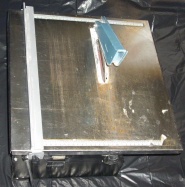Tile cutter
There are several options for cutting tiles.
Score & Snap Machines
- Faster than diamond blade saws
- Significant waste due to tile breakage, though the better ones do much better
- The cut edge of the tile is sharp, a stroke or 2 with a carborundum stone makes it safe.
- Machines that need the tile repositioned between score and snap operations are hard to line up correctly, resulting in even more breakage & waste
- can't cut narrow strips, minimum size is anywhere from 0.5" - 2" to avoid breakage.
- The size of the machine limits the size of tile that can be worked on, especially with diagonal cuts.
- Won't cut some types of tile, eg friable tiles like travertine marble, or heavy textured tiles.
- Quality and longevity of machines varies. One contributor recommends Montolit.
Hand held scorers
These are just a handle with a piece of sharp Tungsten Carbide (TC) or a steel wheel.
- Lowest cost tile cutter
- not recommended on uk.d-i-y
- Snapping pressure tends not to follow the score accurately, causing more breakage loss than with the score and snap machines.
- steel cutting wheels are replaceable, TC bits are regrindable with care and a diamond disc
Cutting:
- Pencil the cut line
- place a straight edge on the tile
- Score
- Put the scored line sitting on matchsticks
- snap tile. Pressing right over the score line causes less breakage
Diamond table saws
- These cut tiles quite quickly, but never as fast as score & snap.
- There is close to zero wastage due to breaking
- Thin tile strips can be cut no problem
- Wet diamond tile saws are very noisy when cutting a tile, use ear protection
- The cut edge is safe rather than sharp
- The typical £30-50 cost soon pays for itself in tile savings
- Usually the table tilts to enable angled cuts
- When close to the end of the cut, to avoid a snapped corner its necessary to reduce tile speed greatly and apply even force very gently to both sides of the tile. This should yield a perfect cut
- Another method is to use a bit of tile offcut as a pusher, and push on the tile being cut where the blade will come to.
- Cuts at an angle can be done by just following a pencil line by eye
- A pencil line may be washed off during cutting, a chinagraph pencil or waterproof marker solves this.
- For straight cuts, the fence is used
- For repeated precision angled cuts, make a tile holder using a thin piece of board and either a few screws to put the tile against, or a strip of wood as a stop.
- Blade cutting rather than score & snap is a necessity for marble
- recomended for porcelain
- These saws produce water spray, especially as the blade spins down, making a minor mess.
- There are water recirculating designs and non recirculating designs, hopefully someone will explain the difference
- These readily produce relatively complex shaped cuts, including notches, L shape cuts, curves etc.
- Some recommend using the machine on a dust sheet to prevent dirty water staining floor coverings.
- Keep a cloth nearby to wipe ceramic and water slurry off the cut tile.
- Eye protection is recommended, but often ignored
- Sitting the machine in a 50x50cm plant tray can help contain the mess.
These saws can generally also be used to cut
- concrete slabs
- stone slabs
- marble
- roof tiles
- fossils
- lumps of quartz for decoration
- flints for decorative walling, etc
- All metals
- sharpening & grinding tiny items only
- attempts to cut used glass just about worked, but poorly
Larger Diamond blade saws
- A sliding cutting head makes angled cuts easier
- Sliding table saws work well too.
Manual saws
Abrasive grit hand saws can cut just about any shape, so are used for the most difficult cuts. Not many tiling jobs need this though.
Hammer
A hammer has one tile cutting application, and that's to produce mosaic tiles. Place whole or part tiles upside down, cover with a cloth, and bash with a hammer. The mix of resulting shapes is well suited to artistic work. Very sharp edges sometimes occur, don't handle carelessly.
If what you want is a square matrix of mosaic tiles, buying them ready stuck to string backing is a lot quicker to work with.
Others
Angle grinders in a stand are sometimes used to cut tiles. These setups are far from ideal, and the blade can overheat, causing blade buckling & tile breakage. There is also no way to easily slide the tile, no guarding, no alignment scales etc. Not nearly as good as proper tile cutters, but some people have got on with them ok.
Free hand grinders have also been used, sometimes with a good result. These have similar downsides.
Die grinders are also used to cut tiles, within limits. Progress is very slow, and doing lots of tiles this way is unworkable. Used in combination with a score and snap machine for making L shaped cuts. Use the grinder for the shorter cut, then score and snap the long cut. The tool pieces to use are diamond cutting disc and abrasive stone.
A continuous rim diamond disc in a tablesaw is also possible. Avoid getting the disc too hot, there's no water cooling.

